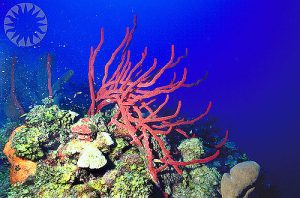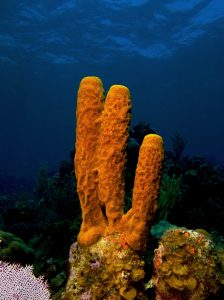40
Organisms
Porifera
Sponges are unique creatures. They are in the Phylum Porifera and there are about 5,000 different known species. They are one of the simplest forms of multi-cellular animals and come in a variety of different colors, shapes, and sizes. Sponges lack organs and a nervous system. They are sessile organisms, attached to reef surfaces via a holdfast. They get their food through filter feeding when the ocean currents go through their pores. There are 4 different classes of sponges; Calcarea (calcareous- has spicules*), Hexactinellida (horn sponges), Demospongiae (coralline), and Sclerospongiae (glass sponges). Each class of sponge is composed of different organic materials. If you want to learn more about sponges and their structure, this is a really informative article about them!

Spicules are “sharp spikes made of calcium carbonate located in the mesohyl. Spicules form the skeleton of many sponges”. Spicules can be a form of defense for the sponges to deter or hurt predators.
Sponges are some of the oldest organisms on earth having been around up to 500 million years! Each individual cell in a sponge can transform to do any function within the sponge. This is a unique and helpful trait to have. An article from Oceana.org even says that “a sponge destroyed in a blender can reform itself as the cells swim back together and take on the form and job needed for recovery”.
Most sponges are also hermaphrodites meaning that each adult can act as either male or female in the reproductive process. Some sponges can also go through asexual reproduction to produce clones when a piece of sponge breaks off and grows in another location!
Sponge fibers help filter water through the organism. This is important because they filter feed on plankton and bacteria while attached to the ocean floor
There are many different types of rope sponge. Row Pore Rope Sponge, Scattered Pore Rope Sponge, Thin Rope Sponge, and so on. They are a tropical sponge that come in a variety of colors, sizes, and depth ranges. This Marine Species Identification portal has some amazing information on marine species.

Tube sponges are another type of tropical sponge. They have a tube shape and also come in a variety of colors, shapes, and sizes. Below is the Yellow Tube Sponge, also known as Aplysina fistularis. The Yellow Tube Sponge has a large opening at the top of it and is attached at the bottom. If they are exposed to the atmosphere, they will turn purple and black and die.

The Barrel Sponge is another common type of tropical sponge. They are called Barrel Sponges because of the way they look. They are bowl shaped and have very large openings (osculum) at the top of them. They grow to be at least 6 feet wide, making them one of the largest sponge species in their habitats. They are homes for a variety of marine life such as shrimps, crabs, gobies, and cardinalfishes.

Fun fact: Giant tube sponges can live up to 2000 years old!!
Sponges are home to an array of microorganisms. Green algae, cyanobacteria, archaea, cryptophytes, red algae, dinoflagellates, heterotrophic bacteria, and diatoms are known to inhabit a range of sponge species. Most microorganisms that regularly inhabit sponges live in symbiosis with the sponges, however parasitic and pathogenic organisms can also affect them. Some microorganisms give corals their vibrant colors. Multiple microorganisms may live in the same sponge at the same time as well. The symbiotic relationship can be either commensalistic or mutualistic, and the types of microorganisms found in and on sponges can have an effect on the sponges growth and development, as well as its color.
The information in this chapter is thanks to content contributions from Sarah Larsen
